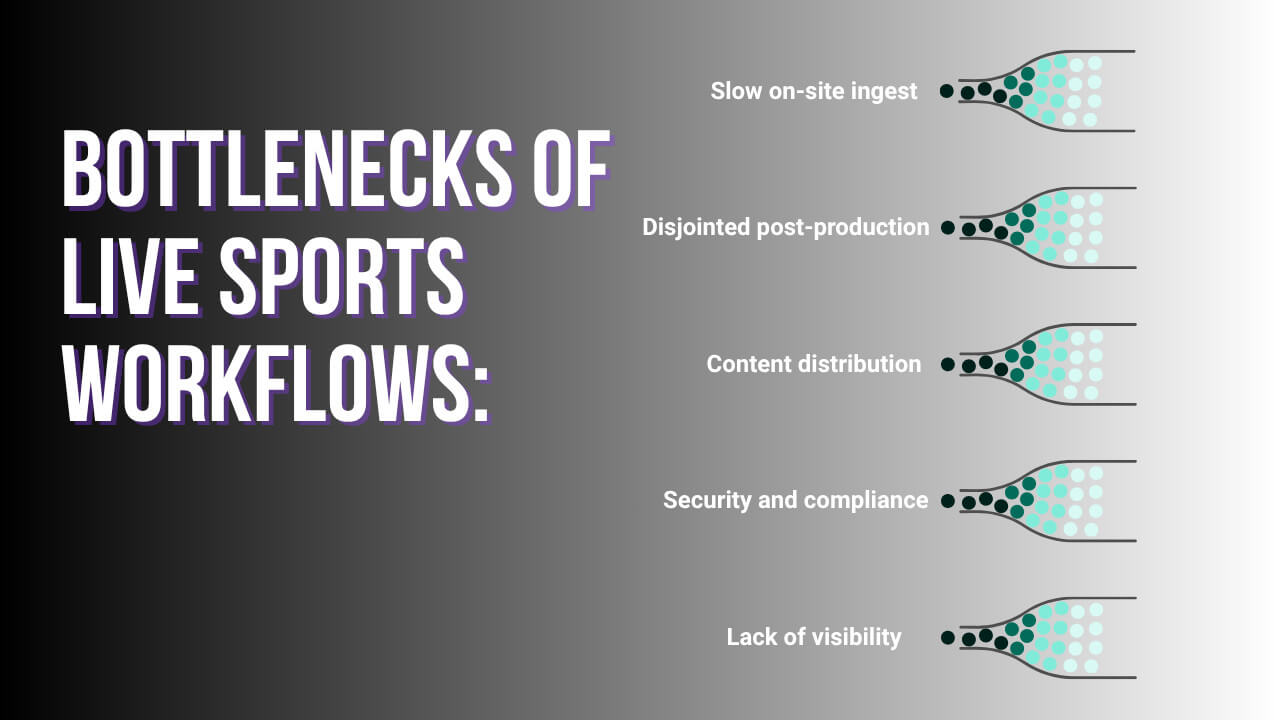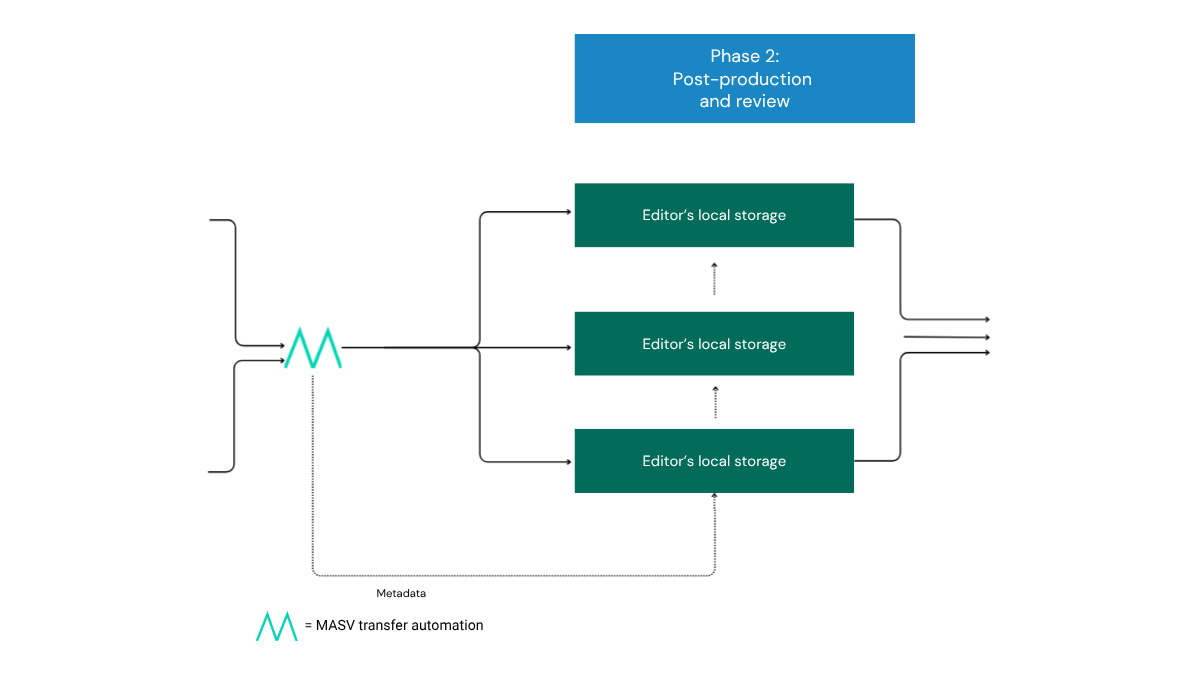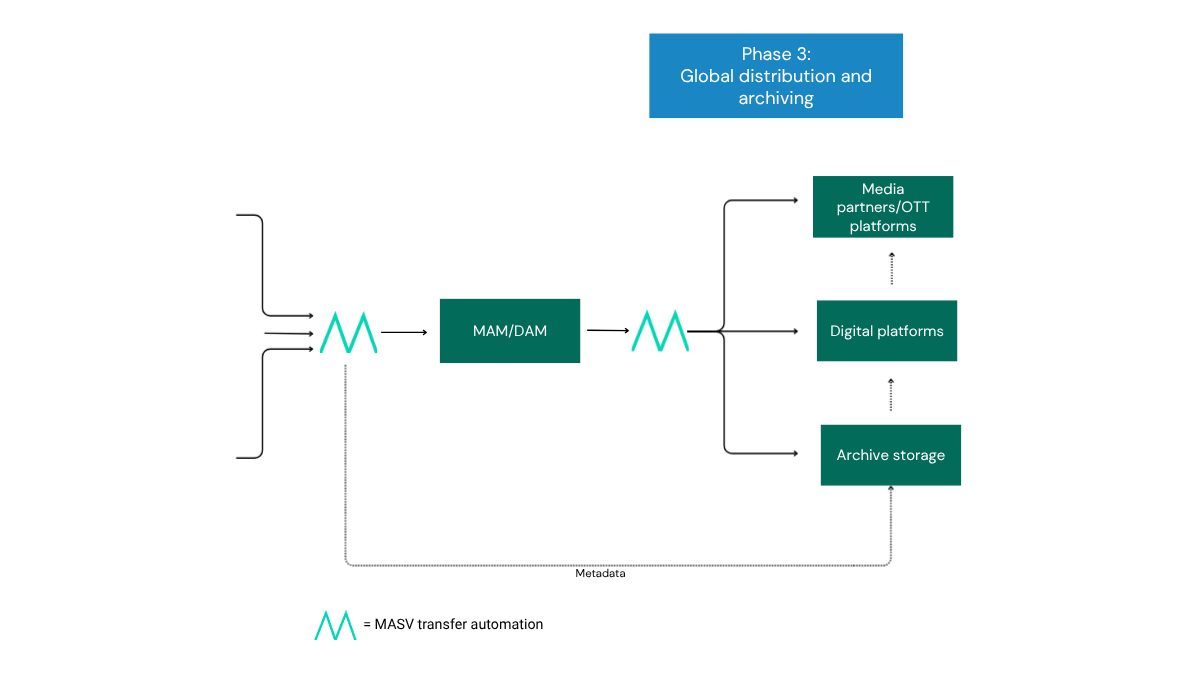The live sports industry produces massive data volumes, from high-res broadcast footage to player stats and promotional content. To stay competitive – and give post teams enough time for post-game beers – efficient live sports workflow automation is essential for ingesting and processing this data in near real-time.
Cloud-based tools enable secure, automated transfer of large files, speeding up post-production and distribution during and after games. MASV’s automation tools simplify these often slow, manual steps into smooth, automated workflows that keep your production running effortlessly.
In this post, we’ll cover the key elements of live sports workflow automation from cloud ingest and remote post-production to rapid content distribution.

Índice de contenidos
Accelerate live sports broadcast
Automate your live sports broadcast content pipeline with MASV.
The Bottlenecks of Today’s Live Sports Workflows
Live sports production moves faster than Messi delivering a devastating penalty kick goal to seal the game for Inter Miami. That’s why delivering high-quality content in real-time – especially as file sizes grow to keep pace with 4K broadcasts – is a necessity.
But several critical bottlenecks continue to hinder efficient video workflows:
- Slow on-site ingest: One of the earliest chokepoints occurs at the stadium or arena. Transferring raw footage to stakeholders remains a time-consuming process that’s prone to failure thanks to large file sizes, limited on-site bandwidth, and logistics constraints. These variables often slow ingest speeds to a crawl, delaying the entire production pipeline.
- Disjointed post-production: Post-production often involves geographically dispersed editors and VFX teams. Without the right tools, this can lead to inefficient collaboration and slower turnaround times. Some clubs and broadcasters ask editors to travel with their teams or to major events to reduce latency during editing – which can be a five-figure expense.

- Content distribution challenges: Delivering finished content simultaneously to multiple broadcasters and digital platforms is similarly complex. Each outlet may have different format requirements, delivery windows, and quality standards – making scalable, real-time distribution difficult to manage without risking delays or errors.
- Security and compliance risks: Sports media assets are highly valuable – the NFL’s rights deal with Amazon, ESPN, NBCUniversal, and CBS is worth an eye-watering $11 billion – and increasingly vulnerable to cyber threats. Yet many organizations struggle to maintain consistent security protocols in workflows involving multiple third parties.
- Lack of visibility: Tracking file packages and confirming successful deliveries is often a manual and fragmented effort, which can create uncertainty, lost files, and production slowdowns.
Addressing these bottlenecks requires fast file transfer for sports along with coordinated solutions integrating content ingest, production, distribution, and security.
The Automated Sports Media Workflow in Action
Leveraging cloud tools to automate sports media and other broadcast workflows has already transformed the way live sports content is produced and delivered. Cloud-based automation enables seamless and secure collaboration across geographically dispersed teams, scalable processing power for faster video ingest and editing, real-time visibility, and simultaneous distribution to multiple platforms.
Cloud-based, nimble tools like MASV work with sports clubs, leagues, broadcasters and other companies that work with live sports content to enable this reality.
Here’s a detailed play-by-play of a live sports workflow automation using MASV integrations and automations, and how it helps get content in front of editors, post teams, and viewers faster.

Phase 1: Ingest & initial processing
a) On-site capture and initial ingest
During and after the game, raw game footage, press conference recordings, and sideline interviews are consolidated at the venue or mobile production unit. The next step is sports video data transfer to get content to editors, post teams, archive storage, and other destinations.
The latter is a traditionally challenging process, from the heavy lift of moving massive files on limited bandwidth (or shipping hard drives) to time-consuming transcoding to make files more manageable.
How an automated workflow helps: Using the Aplicación de escritorio MASV, a Watch Folder – a folder that automatically sends files to a preselected destination as soon as they’re detected in the folder – is configured on a local machine in the OB truck.
Organizations can also use Agente del MASV to automate file delivery to or from local desktops or servers, or the API de MASV to embed automated file transfer into custom workflows.
As soon as new video files are dropped into the folder, MASV automatically detects them and begins an end-to-end encrypted file transfer process.
- The Watch Folder initiates an automated file upload (without needing to zip or transcode first) using a predefined MASV Portal uploader to a recipient, cloud storage, or connected on-prem storage.
- Portals can be configured to multiple locations at once, saving hours of time by avoiding re-uploading footage to multiple destinations.
💡 Nota: Users can configure the MASV API for media to add metadata (such as game ID, date, venue, or other valuable pieces of information) to the file when the Watch Folder is triggered, to improve traceability and organization.
- Users can also add MASV Archivos crecientes capabilities, which initiate the transfer of still-recording files. Sending Growing Files with MASV lets studio editors and reviewers receive footage while it’s still being recorded without having to wait for the initial upload to complete.
- Teams dealing with limited connectivity can add Unión de canales multiconexión to pump up their bandwidth. Multiconnect allows users to bond multiple connections (such as Wi-Fi and 5G) for faster speeds and greater reliability.
b) Centralized storage and asset management
Once uploaded, footage lands in shared storage (such as Amazon S3, Google Cloud Storage, or a Synology NAS) and the broadcaster’s media asset management (MAM) or digital asset management (DAM) system.
How an automated workflow helps: Integraciones MASV directly deliver file packages of unlimited size to cloud or connected on-prem storage and MAMs like Frame.io without manual intervention. Files can be set to automatically land within a specific project or directory in the MAM or storage bucket.
Key stakeholders then receive an automatic notification (via email or Slack) that a new file is ready for review.

Phase 2: Post-production and review
a) Editor access and collaboration
Next, editors and post teams – often geographically dispersed – need immediate access to video proxies or raw footage for producing highlight reels, recaps, social media content, on-demand features, and preparing for post-game or next-day coverage.
In a traditional workflow this happens using local storage, on-site editing suites, and internal networks along with manual file transfer and management processes.
How an automated workflow helps: The MAM system uses a MASV API call to trigger an automated transfer of selected footage directly to a portal MASV dedicated to editor downloads. The MASV Desktop App automatically detects when files are available in the Portal, triggering a download to the editor’s local machine.
- Every video editor with the MASV Desktop App installed on their computer then receives files sent to that Portal automatically, along with a notification.
- That means they don’t have to manually check for new files, deal with slow downloads from general cloud storage interfaces, or drive to the office to download clips from internal networks.
b) Review and approval
Edited highlight reels, interviews, promotional spots, and other items are next reviewed by producers, legal teams, and other stakeholders. But this presents its own suite of problems under a traditional manual workflow, including waiting for files to be posted to an internal server.
How an automated workflow helps: Once approved the final cuts are rendered and placed in a MASV Watch Folder for final edits, which sends to a MASV Portal configured to trigger an instant transfer to any required destinations (such as the MAM and storage) simultaneously.
Because the Portal has been configured to send an automated message to a group of predefined recipients, anyone needing to review the final cuts gets an email letting them know the files are ready and waiting in the MAM.
💡 Nota: Portals can also be configured with custom forms, which can be used at any stage of the workflow – from initial ingest to content distribution. At this stage, editors can use a custom submission notes form to alert reviewers of any important changes or other information.
The review and approval process shifts from a slow, linear, and location-dependent task to a fast, parallel, globally accessible workflow.
For organizations using the MASV API, upon approval in the MAM an API call can trigger a MASV transfer of the final approved asset to the next phase: distribution.

Phase 3: Global distribution and archiving
Recording, ingesting, editing, and approving all that content is a great start, but teams need to play the full 60 minutes to get the W. In this case, that means distributing it to global partners, digital platforms, and archive storage.
a) Distribution to global partners/broadcasters
Finalized broadcast packages, localized content, and promotional videos are rapidly distributed to international media partners, syndication platforms, and streaming services.
How an automated workflow helps: The MAM/DAM uses the MASV API to initiate bulk transfers to preconfigured MASV recipients such as media partners or over-the-top (OTT) platforms.
- Recipient groups and permissions configured by the MASV account’s administrator ensure that each partner receives only the right content.
- The API call includes metadata (such as partner ID and content type) to automate routing and notification.
This replaces manual uploads to disparate FTP servers or cloud links for each partner, ensuring consistent, fast, reliable delivery.
b) Digital platform upload
High-resolution clips are pushed to the right recipients at video-on-demand (VOD) platforms, social media content management teams, league websites, or other destinations.
How an automated workflow helps: A MASV Watch Folder or API trigger automatically uploads specific files to dedicated MASV Portals or directly to cloud storage buckets configured to provide recipient access. MASV can be used to monitor transfer status and trigger notifications that the content is ready for posting.
c) Archiving
All raw footage and final masters are moved to long-term archive storage for historical purposes, future use, and compliance.
How an automated workflow helps: An automated MASV Watch Folder monitors the archive folder in the MAM’s cloud storage, triggering transfers to the archive. MASV can be configured to deliver automatically to cold storage tiers such as Amazon S3 Glacier, Glacier Instant Retrieval, or Glacier Deep Archive, optimizing storage costs and ensuring the correct data gets archived.
The MASV Automation Toolkit
At MASV, we love it when our clients execute on a well-refined game plan – but intricately orchestrated workflows for 4K/8K video transfer simply can’t happen without the right tools.
For a truly automated live sports broadcast workflow, organizations can leverage the following MASV features:
- API de MASV: The backbone for custom integrations with a MAM/DAM or broadcast management system, the MASV API acts as the transport layer for media assets, linking scheduling and distribution metadata to MASV transfers or to the MAM’s metadata, workflow orchestration, and user interface.
- MASV Portals and cloud integrations: Portals can be automated to deliver to more than 20 native integrations with AWS, Google Cloud, and other cloud and connected on-prem storage and MAM platforms without coding or manual intervention.
- Carpetas de vigilancia: A no-code automation solution for automating content uploads and downloads, Watch Folders can seamlessly feed media to editors’ local storage or other preconfigured destinations.
- Multiconnect: A powerful channel bonding feature that combines multiple internet connections to ensure faster, more reliable transfers – even in locations with minimal connectivity.
- Archivos crecientes: Allows transfers to start while a file is still being written, enabling immediate downstream access for editing and other workflows.
- Project management/workflow orchestration tools: Webhooks from MASV can update project status or trigger next steps in third-party tools.
The Game-Winning Benefits of Automated Sports Video Data Transfer
Automating the broadcast media content distribution workflow can have tremendous impact for sports clubs, leagues, broadcasters, and other organizations:
- Unprecedented speed: Enable real-time content delivery, accelerate distribution, boost viewer engagement, expand audience reach, and drive higher advertising revenues while reducing operational costs.
- Increased productivity: Significantly boost the productivity of editors, producers, and post-production staff by streamlining content access, reducing wait times, and minimizing manual tasks.
- Cost predictability: Reduce the need for manual labor and minimize errors that lead to costly delays, leading to lower operational expenses and more efficient resource allocation. Low-latency cloud transfer can also save travel costs for video editing teams that don’t need to be on-site.

- Enterprise-grade, end-to-end security: The value of sports content means an enterprise-grade security posture is a must. MASV encrypts all files at rest and in flight, rides on ultra-secure AWS infrastructure, prevents unauthorized access, and eliminates server access requirements.
- Escalabilidad: Enable broadcasters to efficiently manage growing volumes of content with workflow tools that handle any file volume, from a single game to an entire season, through consistent, repeatable processes.
Live Sports Workflow Automation: A New Era of Sports Broadcasting
And there you have it: A live sports workflow automation seamlessly getting all content where it needs to go at less cost than manual workflows, while leaving production staff, editors, and others with enough time to do their best work (and maybe even go for post-game beers).
But it’s not just about saving time and money – it’s also about staying competitive with other clubs, leagues, and broadcasters who have already made the switch to a cloud-based, automated content workflow with MASV.
MASV’s speed, reliability, ease of use, and potent combination of no-code integrations and automation tools can help you fully automate your sports content ingestion workflow so you can always be ahead of the game.
Regístrate en MASV for free and start testing your sports content workflows today.
Move media faster
Get sports and other broadcast content where it needs to go, faster and more reliably, with MASV.